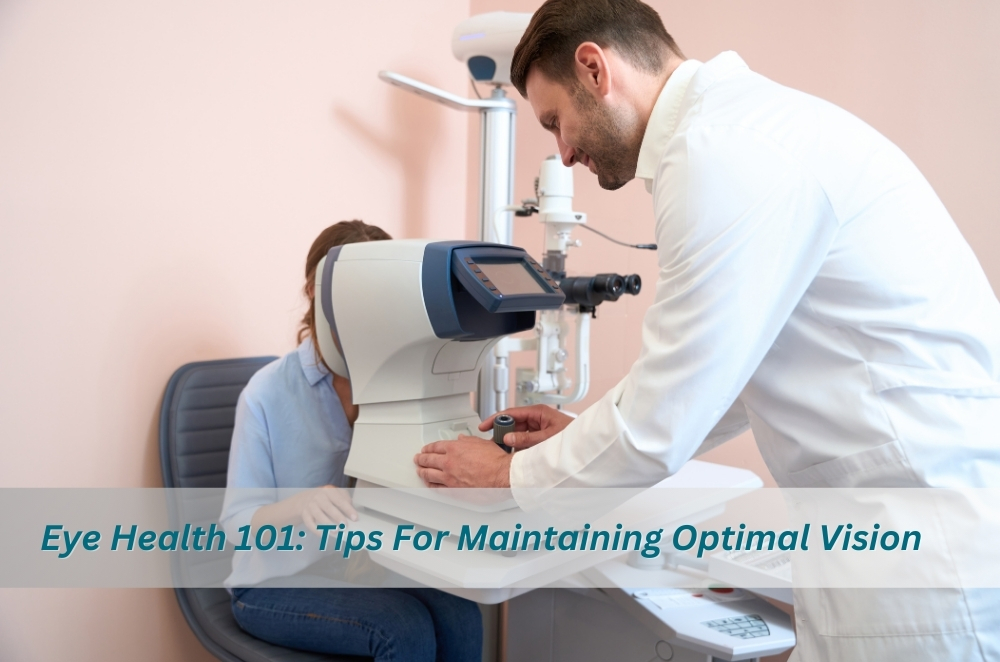Eye Health 101: Tips For Maintaining Optimal Vision

Strong 8k brings an ultra-HD IPTV experience to your living room and your pocket.
Has one ever squinted to see a road sign far away or struggled to read tiny letters on a medicine bottle? It is a shared experience, often also a gentle reminder that now is a perfect time to start paying closer attention to eye health. With the winter chill well and truly setting in right across Canada in January, shorter days translate to less natural light, and the need to have good eyesight is even more acute. Whether one is on the slopes in Whistler or taking in all the colourful ice sculptures on display at Quebec City's Winter Carnival, clear vision elevates everything. Of course, it has lots to do with eye health when it comes to the ability to see, well, literally. It speaks of the essentials in setting up your eyes to conserve such precious sight for the upcoming years. If you struggle to see, this is the perfect time to look into new prescription eyeglasses. You can get prescription glasses for men in Canada.
Understanding eye anatomy and function
The human eye is a technological marvel- a complex assembly of myriad parts working perfectly in coordination and harmony together. From the transparent outer layer of the cornea, which bends light down toward the retina at the back of the eye, everything about the eye has its role to play in our ability to see. This is where the lens focuses that light onto the retina, and it is also the iris that controls only the correct quantity of light being allowed into the pupil. These electrical messages are carried through the optic nerve to the brain, where they are translated into images. Understanding this intricate process helps us appreciate the importance of protecting our eyes.
Essential eye exams and tests
Regular eye exams are non-negotiable for maintaining good eye health. These aren't just about checking your vision; they're comprehensive assessments that can detect early signs of eye diseases, some of which may have no noticeable symptoms in their initial stages. A thorough eye exam typically includes:
- Visual acuity test: A common eye chart will measure the clearness of your vision by testing the sharpness at various distances.
- Refraction test: This will determine your prescription for glasses or contact lenses.
- Eye movement and coordination test: This measures how well your eyes work together.
- Slit-lamp examination: This lets the optometrist examine the front structures of your eye under high magnification.
- Tonometry: This is a test of the pressure inside your eye. It's an essential test for diagnosing glaucoma.
- Dilation: A few drops in the eyes are placed to dilate the pupils so the optometrist can view the back of the eye, which includes the retina and optic nerve.
In general health, any adult can have a comprehensive eye exam once yearly or every other year, depending on one's age or risk factors. Children routinely need an eye exam to make sure their eyes are developing correctly.
Common eye conditions and treatments
There are many eye disorders, from the common refractive errors to the more serious diseases. The most common include:
- Refractive errors: These include myopia, hyperopia, and astigmatism. These are usually corrected with glasses, contact lenses, or refractive surgery.
- Cataracts: these are cloudy lenses of the eye; they cause poor night vision and blurred vision. Examples include surgeries for such conditions.
- Glaucoma: Technically, this is a family of eye conditions that can easily damage the optic nerve due to increased pressure inside the eye. In most instances, treatment is best done at an early age to avoid blindness. There are various modes of treatment, starting with eye drops, medication, laser treatment, and surgery.
- Age-related macular degeneration: AMD is a disease that assaults the central part of the retina, called the macula. This results in distorted central vision. It comes in two types: dry and wet. Unfortunately, AMD is incurable, although several treatments have been developed to help slow the progress of the disease.
- Dry eye syndrome: This is an inability of the eyes to produce adequate tears or to manufacture tears of good quality, leading to discomfort, dryness and blurred vision. Management may be with artificial tears, warm compresses, and modification of lifestyle.
Lifestyle choices for eye health
Our day-to-day living has an immense impact on our eyes. Healthy lifestyle options have a long way to go in maintaining our vision:
Healthy diet: Fruits, vegetables, and omega-3 fatty acids are the major ingredients that provide guaranteed eye health due to simple antioxidants and various essential vitamins for their protection against any type of damage.
Physical workouts: Physical activities mainly enhance the flow of blood in the system, so the eyes become healthy generally.
Wearing sunglasses to guard against the sun's rays: Take advantage of only those sunglasses that block 100% of both UVA and UVB rays because damage from the sun comes without any warning; this is especially important in winters due to reflection power from the snow, which is almost twice of the direct sun's ultraviolet exposure.
Reduction of screen time: Reducing screen time helps a person avoid conditions such as eye strain, dry eyes, and even blurred vision. According to the 20-20-20 rule, in each 20-minute screen, one needs to move and change the gaze on something quite far away for 20 seconds.
Adequate sleep: getting enough sleep enables the eyes to rest and recover.
Avoidance of smoking: Smoking increases the chances of a person developing a range of eye conditions, including cataracts, AMD, and optic nerve damage.
Advanced eye care technologies
Advancements in technology have transformed eye care. The diagnostic and therapeutic skills can now be performed with accuracy. Some recent advances in eye care include:
- Optical coherence tomography: This is a diagnostic test that avails cross-sectional images of the retina, thus aiding in the early detection of diseases such as AMD and glaucoma.
- Laser surgery: There are curative procedures, including LASIK and PRK, which correct the way the light is bent within the eye to correct long-term vision correction.
- IOLs: These are artificial lenses inserted in the eye to replace the cloudy original lens. They help in cataract surgery to achieve clear vision.
Conclusion
Ideal vision requires a lifetime commitment to annual check-ups, healthy lifestyles, and an awareness of possible eye conditions. That way, people-cum-anatomy and the way in which the eye functions, as well as introducing them to new developments, may show a significant amount of interest in continuing and enjoying good eyesight, taking care of this incredibly valued entity in the form of vision. As Canadians hit the snowy streets or go off and take part in some favourite winter sports, so much of their view of the world comes vividly into perspective because one simply looks after one's eyes. Here is all you wanted to know about the eyes. Go to an eye-care professional if you're concerned with expert advice along with individual care.
Note: IndiBlogHub features both user-submitted and editorial content. We do not verify third-party contributions. Read our Disclaimer and Privacy Policyfor details.


